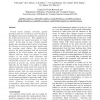Free Online Productivity Tools
i2Speak
i2Symbol
i2OCR
iTex2Img
iWeb2Print
iWeb2Shot
i2Type
iPdf2Split
iPdf2Merge
i2Bopomofo
i2Arabic
i2Style
i2Image
i2PDF
iLatex2Rtf
Sci2ools
119
click to vote
VR
2002
IEEE
2002
IEEE
Perceptual Stability during Head Movement in Virtual Reality
Virtual reality displays introduce spatial distortions that are very hard to correct because of the difficulty of precisely modelling the camera from the nodal point of each eye. How significant are these distortions for spatial perception in virtual reality? In this study we used a helmet mounted display and a mechanical head tracker to investigate the tolerance to errors between head motions and the resulting visual display. The relationship between the head movement and the associated updating of the visual display was adjusted by subjects until the image was judged as stable relative to the world. Both rotational and translational movements were tested and the relationship between the movements and the direction of gravity was varied systematically. Typically, for the display to be judged as stable, subjects needed the visual world to be moved in the opposite direction of the head movement by an amount greater than the head movement itself, during both rotational and translational...
| Added | 16 Jul 2010 |
| Updated | 16 Jul 2010 |
| Type | Conference |
| Year | 2002 |
| Where | VR |
| Authors | P. M. Jaekl, Robert S. Allison, Laurence R. Harris, Urszula Jasiobedzka, H. L. Jenkin, Michael Jenkin, James E. Zacher, Daniel C. Zikovitz |
Comments (0)

